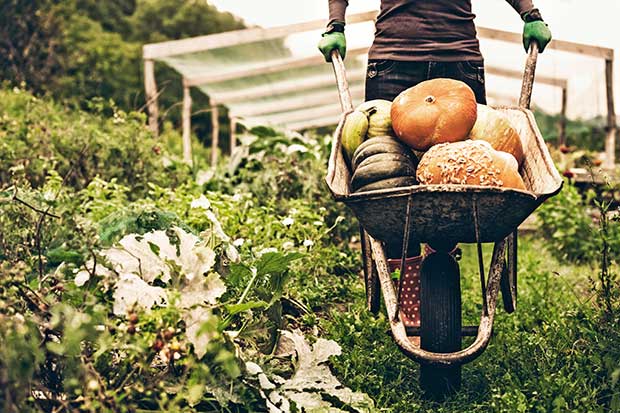8 tips for planting a pumpkin patch of many colours

Whether you like yours white, blue, grey, pale green, orange, striped or knobbly, you can never have too many pumpkins. Or so says this pumpkin lover. A dedicated pumpkin patch will ensure you remain in pumpkin for the whole year.
Words: Jane Wrigglesworth
1. Choose a patch that gets at least six hours of direct sunlight a day and dig in gobs of compost.
2. Traditionally, pumpkins are planted on mounds about 80-90cm in diameter, with moats dug around them. These moats catch water runoff and direct the water to the roots. However, a flat area is just as good, and so too is a sloping bank, provided lots of moisture is supplied.
3. If sowing on mounds, sow four or five seeds directly on top of the mound. Once seedlings have established, thin them out, leaving the two strongest plants to grow.
4. If you’re still experiencing a lot of inclement weather in your area this month, start your pumpkins indoors and transplant when the weather is consistently warm.If cold weather threatens, place a cloche over your seedlings to protect them.
5. As the plants grow over the next few weeks, they’ll need food, and plenty of it. A fish emulsion (available from garden centres, or make your own by soaking fish remains in water) is ideal. A general fertiliser is also good. Feed once a month to provide fat, tasty fruit.
6. After a while, the runners will start to race off, with the main vine growing 10-15m long if you let it. There is also a secondary vine, which usually grows in the opposite direction. As they grow, shoots emerge from the main and secondary vines, which can be selectively pruned so that more energy and effort can go into producing fat fruit on the main and secondary vines, or at the very least so you can control where your vine is heading. Some gardeners also like to remove a few fruit so that the remaining fruit grows larger.
7. Pumpkins are harvested when they have a deep, uniform colour and a hard rind. When you press the rind with your fingers, it should not dent. For most pumpkins this will be after the vines have shrivelled and died but before autumn frosts set in.
8. If storing pumpkins, leave about 5cm of stalk attached to the top. Let your pumpkins cure in the sun for a few days, then store in a dry, cool spot. If storing them in a garage or shed you may want to put them in a simple handmade chicken wire cage, otherwise they may become dinner for the neighbourhood rodents.
Love this story? Subscribe now!
READ MORE
 This article first appeared in NZ Lifestyle Block Magazine.
This article first appeared in NZ Lifestyle Block Magazine.
